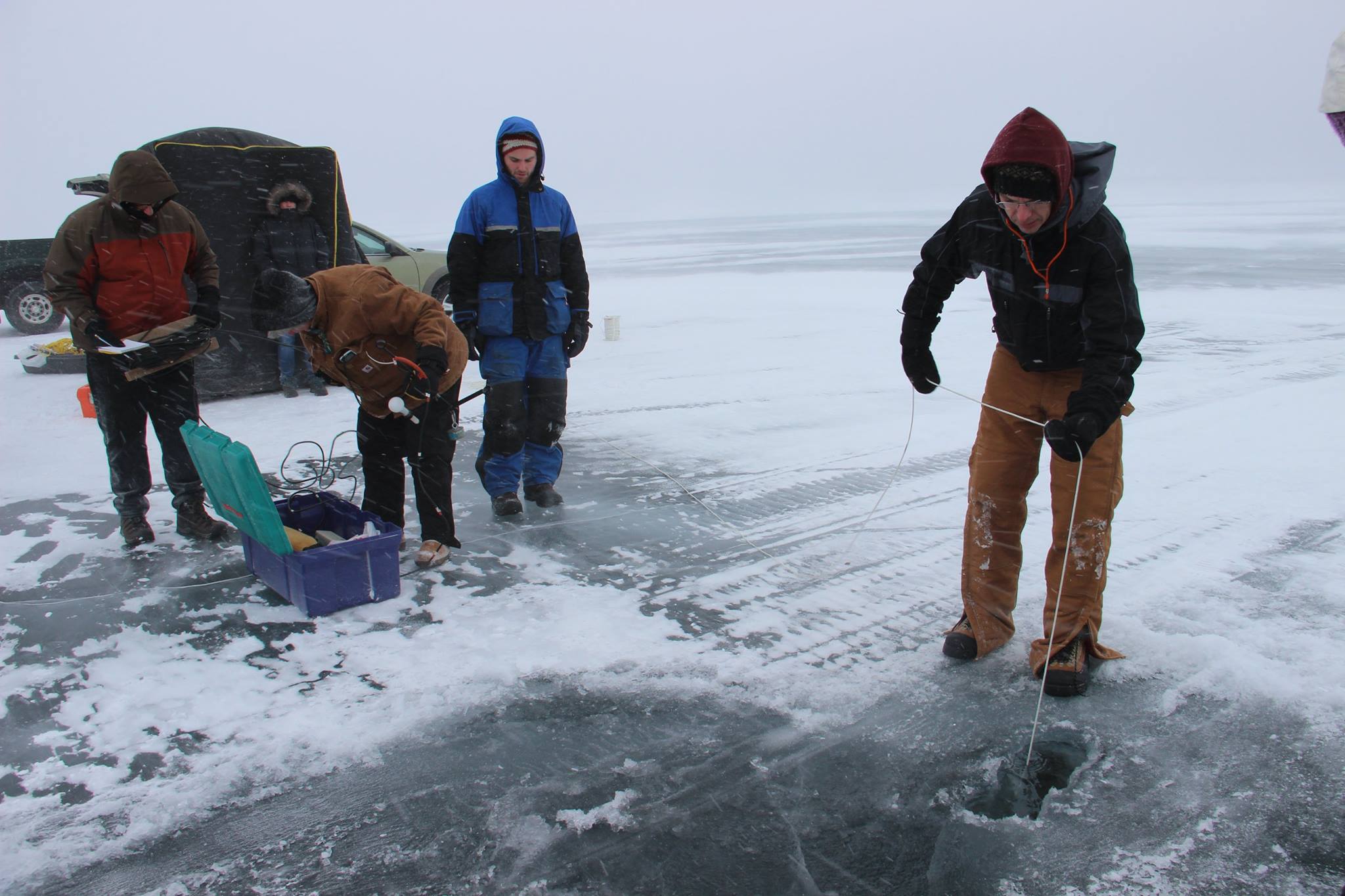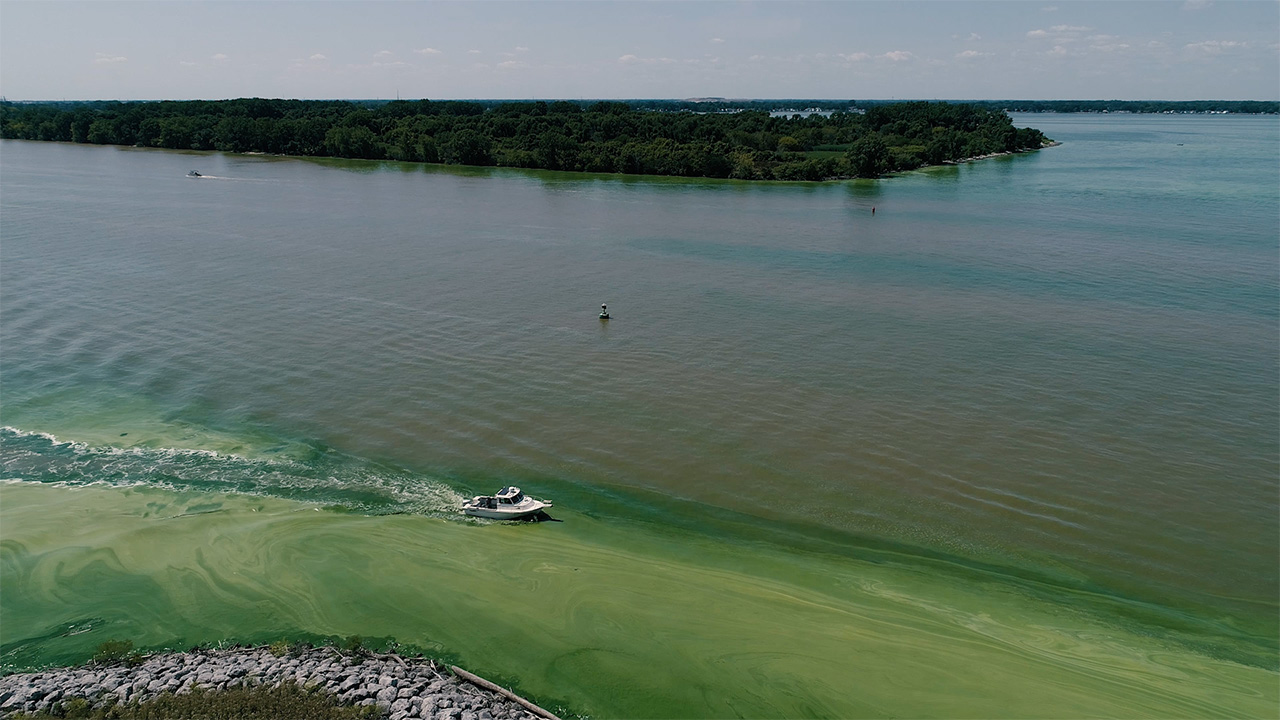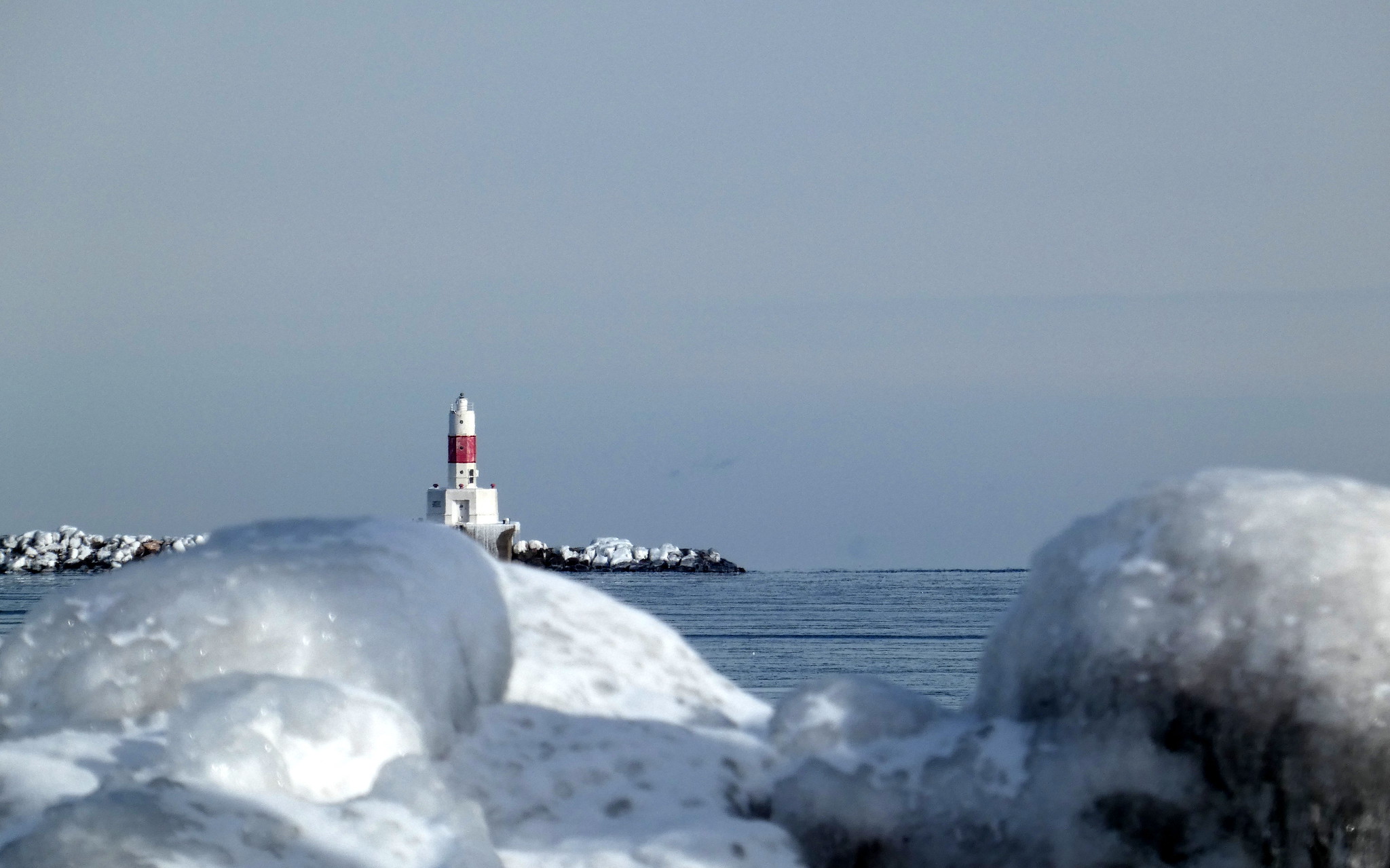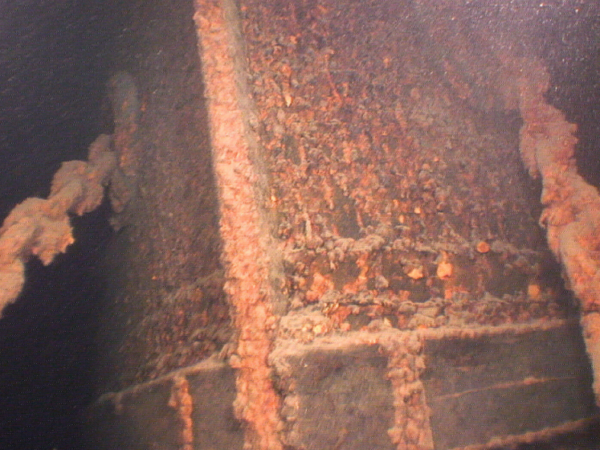
Deep below the cold, dark surface of Lake Superior, sensors strung like pearls along a vertical steel cable sway with the currents. Recording the lake’s dropping temperatures as winter sets in, their gentle rhythm belies their worrying readings: the lake is getting warmer.
Jay Austin heaved several of these science experiments off a boat last fall – tossing concrete blocks into the deep water to anchor the cable of sensors stretching down from floating platforms just below the surface. In the spring, he will collect them and download their readings. Austin is a physicist at the University of Minnesota Duluth’s Large Lakes Observatory who studies the thermal structure of lakes and has been taking Superior’s winter temperature since 2010.

Capt. Rual Lee recovering subsurface flotation after a winter deployment. (Photo Credit: Jay Austin)
He is part of a group of scientists beginning to sound alarms over the lake’s warming.
While Austin’s decade of data is not yet long enough to establish a definitive connection to climate change, he and other researchers are seeing strong evidence of progressively warmer temperatures and diminishing ice cover in Lake Superior.
They have established two things: that Superior is one of the fastest warming lakes in the world and that while ice cover is quite variable, it has diminished by an average of more than 30% since 1973.
“Superior is extremely sensitive to even small changes in winter temperature,” Austin said. “People might say ‘Why should I care? It was 10 (degrees Celsius) warmer yesterday than today.’ But the difference between a high ice year and a low ice year could be just 1 to 2 (degrees Celsius).”
Related stories on Great Lakes Now:
The future of Lake Superior with climate disruption
Why ice matters
Scientists are only beginning to understand the implications of these changes. The challenges of carrying out research over the colder months means there’s a lack of long-term data about some key ecological processes driving climate change-related events.

Technician Jason Agnich recovers an Acoustic Doppler Current Profiler after a winter deployment during which it measured subsurface currents. (Photo credit: Jay Austin)
“It’s like we have this book about the Great Lakes, but we’re missing one-third of the pages,” said Ted Ozersky, Austin’s colleague and fellow lakes researcher. “Besides, people traditionally assumed nothing interesting was going on in the lake in the winter.”
Nothing, it turns out, could be further from the truth.
Over the past decade or so, scientists have been playing catch up. They are now looking closely at winter temperatures, ice cover and the way bands of lake water stratify according to their relative warmth.
They are discovering that something interesting is indeed happening in the cold, quiet months: winter conditions play a big role in determining what happens the following summer.
“We often refer to this as the lake having a ‘memory’ of what’s happened in the past,” said Austin.
The most obvious – and unsettling – sign of rising winter temperatures and dropping ice cover is the recent emergence in Lake Superior of potentially toxin-producing blue-green algal blooms.
The first documented report of blue-green algae in Lake Superior came in 2012, on the shoreline in Wisconsin near the Apostle Islands. There have been several minor blooms since then, culminating in a massive bloom in 2018 that lasted five days and could be seen from space.
Some of these blooms have been tested for toxins, but so far none have come back positive. Yet as Austin said, “it’s the so far part that worries us.”

Harmful algal bloom in western Lake Erie (Great Lakes Now Episode 1013)
Superior is not Erie
Blooms were once unthinkable in the most pristine of the Great Lakes. Superior has little of the algae-promoting nutrient runoff from surrounding land that often triggers damaging blooms in Lake Erie. More importantly, Superior has historically been too cold for algae to proliferate.
But as researchers are coming to understand, changing winter conditions are priming the lake for summertime algal blooms. A winter with little ice cover means the lake is already warm heading into spring, which means it gets warmer faster and stays warm longer.
“While there is an upper thermal threshold for algae, in Superior we are so far away from that. At this point, it’s getting closer and closer to optimal temperatures,” said Ozersky.
Rising temperatures also lead to a longer period of what scientists call lake stratification, a state of affairs that encourages algal blooms, says Brenda Moraska Lafrancois, an aquatic ecologist who works for the National Parks Service in Ashland, Wisconsin.
Stratification happens when a layer of warm water sits on top of a layer of cooler, denser water. Swimmers need only dip below the surface to experience it for themselves.
It’s a natural phenomenon that happens every summer as the lake warms, said Moraska Lafrancois. But lack of winter ice gives that warming a head start. Combined with warmer fall and winter temperatures that delay the ice’s return, this period of stratification now lasts increasingly longer.
Not only is the top layer more hospitable to warmth-loving algae, it’s relatively still because warm water is more buoyant than cold. It doesn’t sink and mix with the lower layers.
“Algae can congregate on the surface and get blown to shore, where it accumulates in shallow, even warmer waters and can bloom,” said Moraska Lafrancois.
Superior state of mind
Researchers agree Superior is a long way from experiencing Lake Erie-type massive blooms that create fish-killing oxygen-deprived dead zones and foul municipal water supplies. But Superior’s unsightly and sometimes smelly blooms could affect the local economy in the years to come as tourists who flock to the lake for its clean, clear waters reconsider holiday plans.
Right now, Lake Superior is still the least abused of the Great Lakes, and the closest to what we might call pristine, said Ozersky.
“Climate change is one of its biggest stressors. We’re not talking about turning Lake Superior into Lake Erie in the next 100 years, but it will change,” he said. “In some ways that are less desirable – algal blooms – and some that might be more desirable – maybe better bass fishing.”

Ice along the Lake Superior shore by Marquette (Photo by yooperann via Flickr, CC BY-NC-ND 2.0)
But perhaps more importantly, such changes could shift the way people who live on Superior’s shores feel about their home. It might force locals to see their lake, the big lake they call Gitche Gumee, as less than pristine.
“People are going to look at the lake and see the difference very clearly,” said Austin. “It will affect our culture. The lake gives us a sense of place.”
This report was made possible in part by the Fund for Environmental Journalism of the Society of Environmental Journalists. SEJ credits The Hewlett Foundation, The Wilderness Society, The Pew Charitable Trust, and individual donors for supporting this project.
Catch more news on Great Lakes Now:
Intense storms from climate change harming Michigan streams and rivers
On Michigan’s inland lakes, ice fishing with less ice, and fewer fish
Warm weather has ice fishing industry on thin ice
Too few farmers are curbing pollution in Lake Erie. Should they be forced?
API key not valid. Please pass a valid API key.Featured image: Jay Austin with students, sampling through the ice on the Madeline Island ice road during winter 2015. Austin is lowering an instrument that will return a profile of temperature throughout the water column. (Photo courtesy of Jay Austin)




